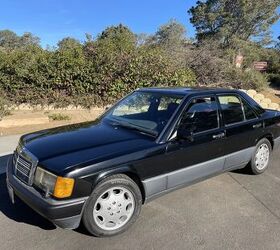We intentionally ran our VW ID.4s down to 0 percent and “0 miles” to see what really happens—GOM accuracy, power limits below 5 percent, warnings, and whether the car still moves at “zero.”
We intentionally ran our VW ID.4s down to 0 percent and “0 miles” to see what really happens—GOM accuracy, power limits below 5 percent, warnings, and whether the car still moves at “zero.”

We also show how we recharged from portable batteries to get back on the road.
Check out the VWIDTalk Podcast on YouTube and wherever you get your podcasts ( Apple Podcasts, Spotify, Overdrive and more).
A transcript, cleaned up by AI and edited by a staffer, is below.
The TTAC Creators Series tells stories and amplifies creators from all corners of the car world, including culture, dealerships, collections, modified builds and more.
[Image: YouTube Screenshot]
Become a TTAC insider. Get the latest news, features, TTAC takes, and everything else that gets to the truth about cars first by subscribing to our newsletter.
Transcript:
Wes: All right, welcome back to the VWD Talk podcast. Thanks to everyone who’s subscribed — it really means a lot. You can also catch us on Apple Music, Spotify, and OverDrive, so make sure to subscribe there too.
Today, Jan and I took one for the team and drove our VWs down to 0% state of charge. Jan did it on purpose, and I did it by accident, but we both hit zero and came back to report what happens when you drive your ID.4 to 0%.
Jan: Exactly. We just wanted to prove that yes, we actually did it. This is also a teaser for another video I made about retrofitting Skoda buttons into the ID.4. But first, let’s answer the main questions from this “drive to zero” test.
Wes: Right — we wanted to know how accurate the GOM (guess-o-meter) is when it shows remaining miles. If you’re at 5% and it says 20 miles, can you trust it? Also, how does the car behave below 5%? Does it lose power? Do you get warnings? And finally, what happens at 0% and 0 miles?
Jan: Let’s roll the video.
Jan (in video):
We’re running the ID.4 to zero. Right now I’m at 9% and 22 miles remaining. I started from 80% and have driven 173 miles since. Funny enough, someone ran out of gas on the highway — I guess we’ll see what happens when I get closer to zero.
Range anxiety is setting in, but I have a 3-kWh backup battery in the trunk just in case. My destination is a church parking lot — maybe divine intervention will help me finish this test.
At 2% state of charge, I’ve got 2 miles remaining. The message pops up: “Battery drained. Charge vehicle now.” I’m at 0% and 0 miles, yet the car still has about 50% power available and continues to drive. Eventually, I get a warning: “Charge vehicle now, otherwise the battery may be damaged.” Time to plug in.
I connected a portable power station to the front charging port. It’s charging at 6.5 kW, which is pretty solid. After about 18 minutes, it’s added 2.3 kWh. The car now shows 2% and 6 miles of range — enough to reach the next charger.
Wes: That’s basically what happened to me too, except I didn’t have extra power in the trunk. Neither of us wanted to keep driving past 0% to trigger turtle mode — it’s not worth the long-term battery risk.
Let’s talk about the GOM accuracy first.
Jan: Yeah, it’s accurate as long as your driving conditions stay consistent. If it’s freezing cold the next day, you’ll get less range, but under normal conditions it’s very linear — almost exact down to the last mile.
Wes: And you were driving about 60 mph in 90°F weather, right?
Jan: Right — around 100 km/h. Perfect weather for this kind of test.
Wes: So below 5%, you noticed reduced power output?
Jan: Yes. On the display, there are two bars — one for recuperation (green) and one for power output (blue). At 0%, the power bar was cut in half, meaning only 50% of power was available. If you floor it, the car doesn’t accelerate like it does at 10% or 20%. That’s intentional — it limits power to protect the battery from voltage drops that could cause damage.
Wes: Makes sense. When you hit 0%, the car still drives but keeps warning you to charge. No buzzers or lights, just constant reminders.
Jan: Right, and even though we’ve heard of “turtle mode,” I didn’t get it at 0%. I was likely driving in the built-in safety buffer that protects the pack.
Wes: We don’t know how big that buffer is, but it’s good to see Volkswagen designed the software to reduce power and prevent damage before that happens.
Jan: Exactly. And I wouldn’t recommend pushing past 0% — there’s no reason to risk it. If you see 20 miles remaining, just plan your next charge.
Wes: Good advice. For anyone new to EVs, range anxiety fades once you’ve driven one for a while. I’ve only forgotten to charge mine a handful of times. One day, I started a long trip at 24%, ran errands all day, and came home with 0%. The car said 0 miles remaining, and my daughter thought we’d be stranded — but we made it.
The system is smart enough to protect itself. The software keeps a buffer so you’re not really running on “empty,” even when it says zero.
Jan: Speaking of charging — when I used my portable batteries, the output was about 7.4 kW, but the car showed 6.5 to 7. There’s some efficiency loss because the portable units convert DC to AC, and then the car converts AC back to DC. Slower charging speeds can improve that efficiency slightly.
Wes: That’s good to know. Overall, great experiment — and good to see how well the ID.4 manages low charge situations.
Jan: Exactly. Thanks for watching, everyone. Hopefully this gives you some peace of mind about driving close to zero. Stay tuned for our next episode.
Wes: Thanks, everyone. See you next time.












